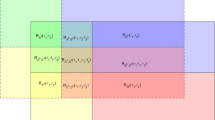Abstract
This paper presents a multi-rate quasi-synchronous CDMA (QS-CDMA) system with QPSK modulation based on the new signature waveforms, namely GPZ-chip waveforms which are constructed by the generalized pairwise Z-complementary (GPZ) codes and optimal chip waveforms. According to the properties of GPZ-chip waveforms, the multiple access interference of different users can be reduced or eliminated. The interferences among different streams of the same user are handled by an optimal (or suboptimal) multi-stream detector(s). The performance of the proposed system is simulated and analyzed in a cellular communication environment consisting of multipath fading. The result shows that the proposed system has similar performance as compared to the single-rate QS-CDMA system employing GPZ codes with one chip waveform due to the properties of multi-stream detection. Also, the proposed system can achieve a significant interference reduction as compared to the multi-rate system employing concatenated WH/m sequence sets with one chip waveform due to the zero correlation zone properties of the GPZ-chip waveforms, thus resulting better BER performance.
Similar content being viewed by others
References
Pursley M. B. (1977) Performance evaluation for phase-coded spread-spectrum multiple-access communication-part I: system analysis. IEEE Transactions on Communication COM-25(8): 795–799
Pursley M. B., Sarwate D. V. (1977) Performance evaluation for phase-coded spread-spectrum multiple-access communication-part II: Code sequence analysis. IEEE Transactions on Communication COM-25(8): 800–803
Tang X. H., Mow W. H. (2006) Design of spreading codes for quasi-synchronous CDMA with intercell interference. IEEE Journal on Selected Areas in Communications 24(1): 84–93
Fan P. Z., Hao L. (2000) Generalized orthogonal sequences and their applications in synchronous CDMA systems. IEICE Transactions on Fundamentals E83-A(11): 1–16
Deng X., Fan P. (2000) Spreading sequence sets with zero correlation zone. Electronics Letter 36(11): 993–994
Fong M. H., Bhargava V. K., Wang Q. (1996) Concatenated orthogonal/PN spreading sequences and their application to cellular DS-CDMA system with integrated traffic. IEEE Journal on Selected Areas in Communications 15(3): 547–558
Salmasi, A., & Gilhousen, K. S. (1991). On the system design aspects of code division multiple access(CDMA) applied to digital cellular and personal communications networks. Proceedings of IEEE Vehicular Technology Conference (pp. 57–62).
Fong, M. H., Wang, Q., & Bhargava, V. K. (1994). Concatenated orthogonal/PN codes for DS-CDMA systems in a multiuser and multipath fading environment. Proceedings of IEEE Globecom (pp. 1642–1646).
Chen H. H., Yeh Y. C., Zhang X., Huang A., Yang Y., Li J., Xiao Y., Sharif H. R., Vinck A. J. H. (2006) Generalized pairwise complementary codes with set-wise uniform interference-free windows. IEEE Journal on selected areas in communications 24(1): 65–74
Feng L. F., Fan P. Z., Tang X. H., Loo K.-K. (2008) Generalized pairwise Z-complementary codes. IEEE Signal Processing Letters 15(1): 377–380
Geraniotis E. A., Pursley M. B. (1985) Performance of coherent direct-sequence spread-spectrum communications over specular multipath fading channels. IEEE Transactions on Communications COM-33: 502–508
Amoroso F. (1980) The bandwidth of digital signals. IEEE Communications magazine 18: 13–24
Nguyen H. H., Shwedyk E. (2002) Bandwidth constrained signature waveforms and Walsh signal space receivers for synchronous CDMA systems. IEEE Transactions on Communication 50: 1137–1149
Nguyen, H. H., & Shwedyk, E. (2000). Lower bound on the total squared correlation of the bandwidth constrained, time-limited signal sets. In Proceedings of IEEE International Symposium on Information Theory (p. 378). Sorrento, Italy.
Cheng, R. S., & Verdú, S. (1989). Optimal signal design for band-limited PAM synchronous multiple-access channels. In Proceedings of 23rd Conference Information Sciences and Systems (pp. 321–326). Baltimore, MD.
Proakis J. G. (1983) Digital communicutions. McGraw-Hill, New York
Author information
Authors and Affiliations
Corresponding author
Additional information
This work was supported in part by the National Science Foundation of China (NSFC) under the Grant No. 60772087/90604035, the 111 Project under the grant No.111-2-14, the National 863 High-Tech R&D Program under the grant No.2007AA01Z228, and the Program for New Century Excellent Talents in University (NCET) under the grant No. NECT-05-0795.
Rights and permissions
About this article
Cite this article
Feng, L., Fan, P., Loo, KK. et al. New Signature Waveforms for Multi-rate QS-CDMA System with QPSK Modulation. Wireless Pers Commun 55, 273–288 (2010). https://doi.org/10.1007/s11277-009-9801-5
Received:
Accepted:
Published:
Issue Date:
DOI: https://doi.org/10.1007/s11277-009-9801-5




